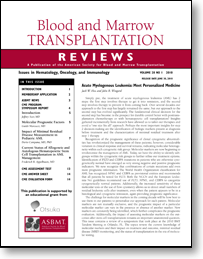Therapy for Acute Myelogenous Leukemia: What Therapy and When?
by Jack W. Hsu and John R. Wingard
Simply put, the treatment of acute myelogenous leukemia (AML) has 2 steps: the first step involves therapy to get it into remission, and the second step involves therapy to prevent it from coming back. Over several decades our approach to the first step has largely remained the same, but our approach to the second step has evolved significantly. The fundamental clinical decision for the second step has become: is the prospect for durable control better with posttransplantation chemotherapy or with hematopoietic cell transplantation? Insights gathered incrementally from research have allowed us to tailor our therapies and avoid a “one size fits all” approach. Perhaps the most important insights for step 2 decision-making are the identification of biologic markers present at diagnosis before treatment and the characterization of minimal residual treatment after step 1 therapy.
Recognition of the prognostic significance of clonal cytogenetic abnormalities has revolutionized the management of these patients; however, considerable variation in clinical response and survival remains, indicating molecular heterogeneity within each cytogenetic risk group. Molecular markers are now beginning to revolutionize the management of AML. Today, we have the ability to identify subgroups within the cytogenetic risk groups to further refine our treatment options. Identification of FLT3 and CEBPA mutations in patients who are otherwise cytogenetically normal have emerged as very strong negative and positive prognostic indicators. We now recognize that combinations of certain mutations add even more prognostic information. The World Health Organization classification for AML has recognized NPM1 and CEBPA as provisional entities and recommends that all patients be tested for FLT3. Both the NCCN and the European Leukemia Net guidelines recommend use of FLT3, NPM1, and CEBPA to categorize cytogenetically normal patients. Additionally, the increased sensitivity of these molecular tests or the use of flow cytometry allows us to detect small numbers of residual leukemic cells after treatment, even when the patient appears to be in a histological and cytogenetic remission, again providing prognostic significance.
The challenge for molecular markers in the coming decade will be how best to use them in our patients to personalize our approach for each patient. Molecular markers are not mutually exclusive, and the prognostic impact of a particular molecular marker can vary in the presence or absence of another marker. New markers are constantly being identified, which further complicates the prognostic evaluation. Additionally, the impact of assessing molecular markers on the outcomes after stem cell transplantation remains an important unanswered question. This issue contains a review of a symposium that took place at the 2010 BMT Tandem Meeting in Orlando, FL. The topics review the current knowledge of molecular markers and their impact on treatment and outcome, minimal residual disease (MRD) monitoring, and the status of transplantation in the era of molecular testing.
Download a PDF version of the full issue.

